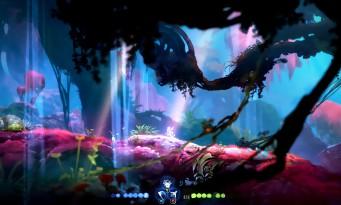 One of the main criticisms that had been made to Ori and the Blind Forest concerned its too high difficulty. Ori and the Will of the Wisps immediately avoids this pitfall since we find the three levels of difficulty that had been introduced in the Definitive Edition of its predecessor. But that's not all. The free backup system which required you to spend an energy point and, above all, to think regularly about placing a checkpoint, has disappeared in favor of an automatic checkpoint system. The "die & retry" aspect then becomes much less painful since we systematically reappear a few meters from the place of our death. We will also see a little later that other tools are available to make life easier for players. But before getting into the details of the gameplay, let's take a look at the storyline, which directly follows on from the 2015 one. The Blind Forest. In love with freedom, the latter ends up flying away with Ori in search of new horizons, beyond the waters. A storm forces them to land on the lands of Niwen. A disaster for Ori and Kun who find themselves separated from their friends (and even separated from each other), but good news for the player, who enjoys new environments to explore.
One of the main criticisms that had been made to Ori and the Blind Forest concerned its too high difficulty. Ori and the Will of the Wisps immediately avoids this pitfall since we find the three levels of difficulty that had been introduced in the Definitive Edition of its predecessor. But that's not all. The free backup system which required you to spend an energy point and, above all, to think regularly about placing a checkpoint, has disappeared in favor of an automatic checkpoint system. The "die & retry" aspect then becomes much less painful since we systematically reappear a few meters from the place of our death. We will also see a little later that other tools are available to make life easier for players. But before getting into the details of the gameplay, let's take a look at the storyline, which directly follows on from the 2015 one. The Blind Forest. In love with freedom, the latter ends up flying away with Ori in search of new horizons, beyond the waters. A storm forces them to land on the lands of Niwen. A disaster for Ori and Kun who find themselves separated from their friends (and even separated from each other), but good news for the player, who enjoys new environments to explore.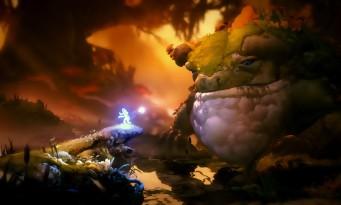 As for the Will of the Wisps that gives the game its title, it will be needed to restore harmony to Niwen. The cutscenes tell it all brilliantly. Worthy of a real cartoon (and more of a Miyazaki/Ghibli trend than an ugly American television cartoon), they benefit from extremely detailed animations (just like the gameplay phases for that matter) and showcase a fabulous artistic direction, both bright and dark, shimmering and soft. The work on light and colors is absolutely perfect. And if the game starts again in a forest, it then gives us the opportunity to admire relatively new landscapes. We think in particular of this lush tropical environment, or even of these orange desert expanses accompanied by slightly Arabic music (just enough to stick to the atmosphere without ever falling into caricature). Because, yes, once again the soundtrack hits very hard. The compositions always ring true and support the action admirably without ever taking precedence over it.
As for the Will of the Wisps that gives the game its title, it will be needed to restore harmony to Niwen. The cutscenes tell it all brilliantly. Worthy of a real cartoon (and more of a Miyazaki/Ghibli trend than an ugly American television cartoon), they benefit from extremely detailed animations (just like the gameplay phases for that matter) and showcase a fabulous artistic direction, both bright and dark, shimmering and soft. The work on light and colors is absolutely perfect. And if the game starts again in a forest, it then gives us the opportunity to admire relatively new landscapes. We think in particular of this lush tropical environment, or even of these orange desert expanses accompanied by slightly Arabic music (just enough to stick to the atmosphere without ever falling into caricature). Because, yes, once again the soundtrack hits very hard. The compositions always ring true and support the action admirably without ever taking precedence over it.
ONLY ORI CAN DO BETTER THAN ORI
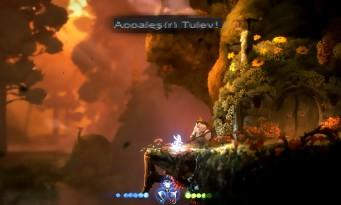 So it's established: in terms of atmosphere, graphics and music, The Will of the Wisps is the worthy heir to The Blind Forest. But the gameplay is no exception. In 2020 as in 2015, we are entitled to extremely precise platforming phases, controls that respond to the finger and the eye and a multitude of movements. We thus find the double jump, the rush, the feather to hover, or the strike allowing to reorient itself when it is applied to a lantern, an enemy or a projectile (the latter can then also be redirected where desired) . These tools are put to good use both in calm and sedate scenes that sometimes focus on puzzles, and in sequences of hectic chases. But Ori and The Blind Forest already offered all that, you might argue. And indeed one could legitimately think that this small masterpiece is sufficient in itself. There was a great risk of developing a "useless" sequel that could have been the subject of a simple extension.
So it's established: in terms of atmosphere, graphics and music, The Will of the Wisps is the worthy heir to The Blind Forest. But the gameplay is no exception. In 2020 as in 2015, we are entitled to extremely precise platforming phases, controls that respond to the finger and the eye and a multitude of movements. We thus find the double jump, the rush, the feather to hover, or the strike allowing to reorient itself when it is applied to a lantern, an enemy or a projectile (the latter can then also be redirected where desired) . These tools are put to good use both in calm and sedate scenes that sometimes focus on puzzles, and in sequences of hectic chases. But Ori and The Blind Forest already offered all that, you might argue. And indeed one could legitimately think that this small masterpiece is sufficient in itself. There was a great risk of developing a "useless" sequel that could have been the subject of a simple extension.
Ori and the Will of the Wisps indeed presents us with many more characters than its predecessor. It is also possible to speak to them, the dialogues then appearing on the screen.
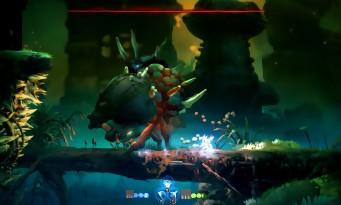 This is also an idea that will certainly cross the minds of many players at the start of the game. At first it's hard to be surprised especially when, like yours truly, we replayed The Blind Forest recently. Fortunately, developers at Moon Studios have actually not been stingy with new things. Some are minor, like those gas bubbles you can bounce off of, or those bars you can spin around like a gymnast. But others are much more important, like this grappling hook with which you can project yourself towards certain elements, this blue “velcro” foam which allows Ori to move upside down, or even the burying mechanics. Thanks to the latter it is possible to move in the sand like a torpedo and even to reverse the enemies which are on the surface (practical to remove the shell of an otherwise invincible creature). Beyond these considerations of pure gameplay, we will see that the general structure of the game has also changed.
This is also an idea that will certainly cross the minds of many players at the start of the game. At first it's hard to be surprised especially when, like yours truly, we replayed The Blind Forest recently. Fortunately, developers at Moon Studios have actually not been stingy with new things. Some are minor, like those gas bubbles you can bounce off of, or those bars you can spin around like a gymnast. But others are much more important, like this grappling hook with which you can project yourself towards certain elements, this blue “velcro” foam which allows Ori to move upside down, or even the burying mechanics. Thanks to the latter it is possible to move in the sand like a torpedo and even to reverse the enemies which are on the surface (practical to remove the shell of an otherwise invincible creature). Beyond these considerations of pure gameplay, we will see that the general structure of the game has also changed.
ORI TURNS
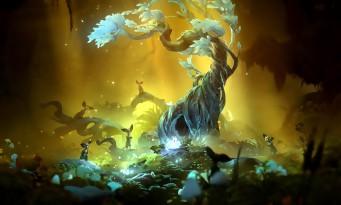 Ori and the Will of the Wisps indeed presents us with many more characters than its predecessor. It is also possible to speak to them, the dialogues then appearing on the screen. These interlocutors regularly offer us small quests which generally boil down to bringing a particular object to a given person. But some inhabitants have a more specific role, such as this craftsman capable of repairing structures, this gardener planting seeds or the various sellers (of cards, skills, etc.). We even have a (non-interactive) inventory in which the various quest objects are automatically stored. In addition, certain characters sometimes tell us about rumors, in order to subtly guide us on the next place to visit. For the record, let us specify that one of the inhabitants gives us access to an incredibly detailed statistics screen since it gives access to thirty-five types of information (number of jumps, number of drownings, number of strikes, distance traveled, longest time in the air, distance dug…). The presence of all these allied creatures inevitably enriches the universe of the game but, in return, the narration seems a little less refined than in the previous part. Having to exchange the spiritual light harvested in the levels for skills and literally being offered by the seller a discount for our first purchase breaks the poetic aspect a bit.
Ori and the Will of the Wisps indeed presents us with many more characters than its predecessor. It is also possible to speak to them, the dialogues then appearing on the screen. These interlocutors regularly offer us small quests which generally boil down to bringing a particular object to a given person. But some inhabitants have a more specific role, such as this craftsman capable of repairing structures, this gardener planting seeds or the various sellers (of cards, skills, etc.). We even have a (non-interactive) inventory in which the various quest objects are automatically stored. In addition, certain characters sometimes tell us about rumors, in order to subtly guide us on the next place to visit. For the record, let us specify that one of the inhabitants gives us access to an incredibly detailed statistics screen since it gives access to thirty-five types of information (number of jumps, number of drownings, number of strikes, distance traveled, longest time in the air, distance dug…). The presence of all these allied creatures inevitably enriches the universe of the game but, in return, the narration seems a little less refined than in the previous part. Having to exchange the spiritual light harvested in the levels for skills and literally being offered by the seller a discount for our first purchase breaks the poetic aspect a bit.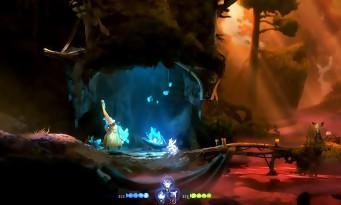 Another important novelty concerns the appearance of a system of spiritual fragments to be equipped. There are about thirty of them and their effects are extremely varied: orb magnet, adhesion to walls, increase in damage given and received, resistance to blows, additional life cell, vital harvest so that enemies generate more life orbs, thorn to inflict damage on creatures that touch us, etc. The problem is that the number of slots to accommodate the fragments is limited. At the beginning, we even tend to rail against this system which forces us to make difficult choices, even to juggle between different configurations depending on the situation. But during the adventure, we come across shrines that offer us to carry out different challenges. The reward is extremely motivating since it consists of an increase in the number of shard slots.
Another important novelty concerns the appearance of a system of spiritual fragments to be equipped. There are about thirty of them and their effects are extremely varied: orb magnet, adhesion to walls, increase in damage given and received, resistance to blows, additional life cell, vital harvest so that enemies generate more life orbs, thorn to inflict damage on creatures that touch us, etc. The problem is that the number of slots to accommodate the fragments is limited. At the beginning, we even tend to rail against this system which forces us to make difficult choices, even to juggle between different configurations depending on the situation. But during the adventure, we come across shrines that offer us to carry out different challenges. The reward is extremely motivating since it consists of an increase in the number of shard slots.
THE METROIDVANIA FOR ALL
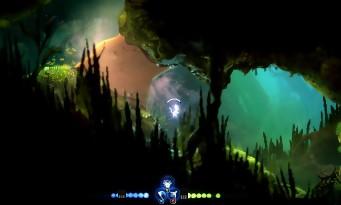 Once these expansions are unlocked, the shard system seems much more interesting, even if some of these shards don't actually seem useful and are there for filler. In the end, this system allows you to customize your style of play and is therefore appreciable. The same goes for the skills that can be assigned to the three buttons of the controller (the fourth being reserved for jumping) but which are much more numerous than that. Here again, we will have to make draconian choices between the spiritual blade which transforms Ori into a real little samurai, the brazier to ignite enemies, the spiritual bow, the boomerang star, the orb which attacks alone, the spear of light and we go. Of particular note is the regeneration skill, which allows you to use energy to recover life. When we told you that everything has been done to make life easier for players! But here again, the interest of this system of "too many" skills lies in the possibility for the player to personalize his style of combat (rather passive or rather active, in close combat or at a distance, etc.).
Once these expansions are unlocked, the shard system seems much more interesting, even if some of these shards don't actually seem useful and are there for filler. In the end, this system allows you to customize your style of play and is therefore appreciable. The same goes for the skills that can be assigned to the three buttons of the controller (the fourth being reserved for jumping) but which are much more numerous than that. Here again, we will have to make draconian choices between the spiritual blade which transforms Ori into a real little samurai, the brazier to ignite enemies, the spiritual bow, the boomerang star, the orb which attacks alone, the spear of light and we go. Of particular note is the regeneration skill, which allows you to use energy to recover life. When we told you that everything has been done to make life easier for players! But here again, the interest of this system of "too many" skills lies in the possibility for the player to personalize his style of combat (rather passive or rather active, in close combat or at a distance, etc.).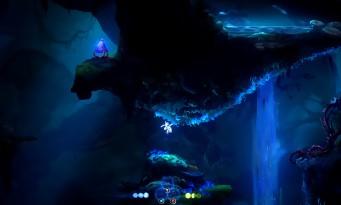 By combining the right skills with the right fragments, there is a way to greatly increase your chances of survival and, above all, to adapt the gameplay to your desires. Finally, it is impossible not to praise the brilliant level design of this new Ori. The codes of metroidvania are perfectly mastered, so much so that the game will appeal even to people allergic to the genre. Relax, if you stumble too much on a passage, you will have to come back to it later when your character is more evolved. The developers have gone so far as to prevent us from turning around in certain precise places, so that we understand that we have all the tools in hand to solve the problem and that, this time, we must persevere and not try to put off the action. All this means that you rarely get lost and that you almost never make useless or involuntary round trips. So whether you like metroidvania or not, go for Ori and the Will of the Wisps!
By combining the right skills with the right fragments, there is a way to greatly increase your chances of survival and, above all, to adapt the gameplay to your desires. Finally, it is impossible not to praise the brilliant level design of this new Ori. The codes of metroidvania are perfectly mastered, so much so that the game will appeal even to people allergic to the genre. Relax, if you stumble too much on a passage, you will have to come back to it later when your character is more evolved. The developers have gone so far as to prevent us from turning around in certain precise places, so that we understand that we have all the tools in hand to solve the problem and that, this time, we must persevere and not try to put off the action. All this means that you rarely get lost and that you almost never make useless or involuntary round trips. So whether you like metroidvania or not, go for Ori and the Will of the Wisps!


























